How To Pick A Good Watermelon
Here are six tips for How to Pick a Good Watermelon that’s ripe and sweet, gathered from lots of conversations with produce people, farmers, and personal experience. If you know how to check for things like the field spot, it makes the selection process much easier!
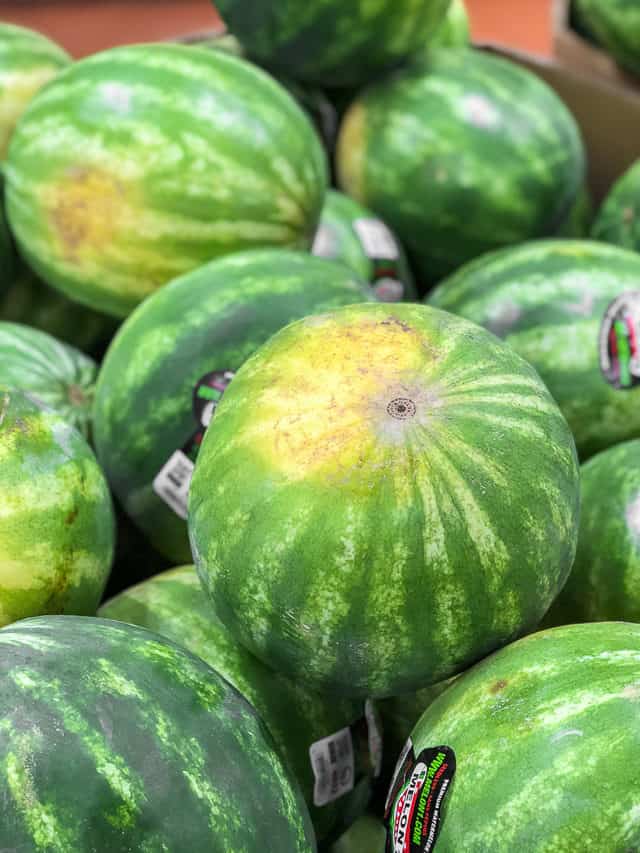
Picking out a perfect watermelon at the grocery store was always a semi-anxiety plagued experience for me when I didn’t know what I was looking for.
If you pick a bad one, you’re stuck with 15-20 whopping pounds of watermelon terribleness. And then your options are to either force yourself to eat this yucky watermelon or throw it away…and both are less than desirable options.
There have been a few times where I ended up throwing it out because it tasted like a crunchy watermelon rind cucumber, and no one in my family would eat it.
My goal today is to help you pick a sweet, ripe watermelon because I know how disappointing it is to get home, take your first bite of some sort of produce you buy, only to find out it isn’t good.
All the tips here are tidbits I have gathered from personal experience and lots of conversations with produce people and farmers. Here’s how to pick the best watermelon!
Tip #1: Find the Field Spot
If you don’t even read the other tips, I find this is the biggest indicator of a good watermelon.
The field spot, or ground spot, is a creamy spot on the outside, and it’s where the watermelon was resting on the ground, or the underside of the watermelon.
The field spot should be a yellowish creamy color, like shown with my watermelon:
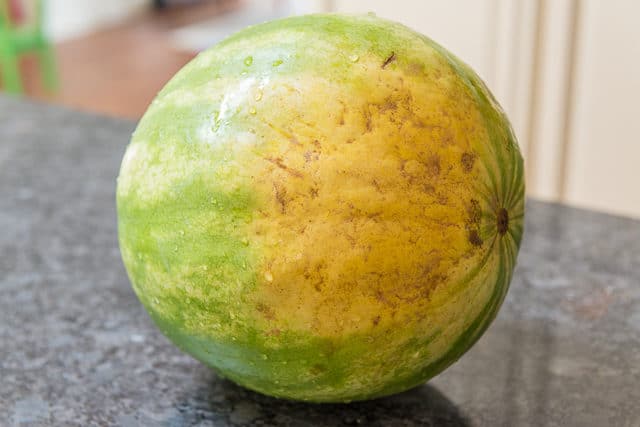
The more dark yellow the field spot is, the longer it was on the vine sweetening up. If the field spot is a white spot (or not even there), this indicates an underripe melon.
What’s interesting is you’ll notice that the other side of the same watermelon looks completely different:
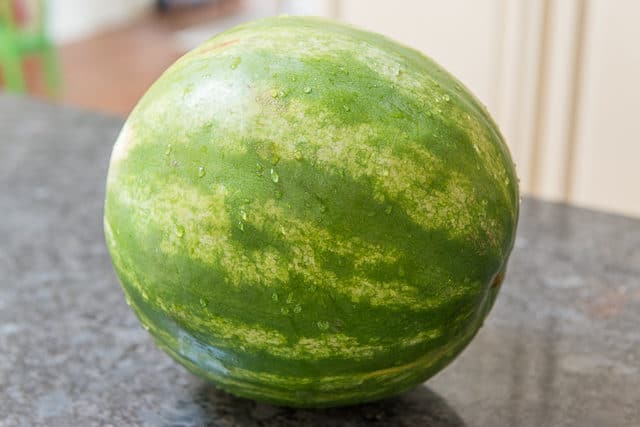
It’s much prettier and more typical of what I picture when I think of a watermelon, and that’s okay.
I find that the best watermelons I buy can sometimes look really gnarly on one side, usually the underside of the melon where it was resting on the ground, and then unblemished on the other. But you don’t want it to look perfectly green all the way around.
Note: It’s fine if there are green stripes, or not, or if there’s solid green color on most of the outside of the watermelon. The exterior pattern is more about the varieties of watermelons that your grocery store carries, and not anything to do with being a ripe melon or not.
Tip #2: Pick a Dull Looking Exterior
A shiny exterior appearance indicates an underripe watermelon, though this can be a bit tricky if they’ve added wax, and then you can’t really tell. This applies to honeydew melons too. Don’t be put off by a dull looking watermelon.
Tip #3: Knock on It with Your Knuckles
Your knuckles should bounce off the melon, and the surface should be pretty hard and firm. You will get a dull thud if the flesh is soft, which indicates it’s starting to spoil. Avoid any melon with soft spots!
Rather than a dull thud, you are looking for a hollow sound, a deep sound. It takes a lot of testing to learn what this sounds like, so don’t use it as your only indicator.
If you don’t want to knock with your knuckles, then you can push firmly with the tip of your thumb. Ideally there should be little or no give when you push in.
Tip #4: Get the Heaviest One for Its Size
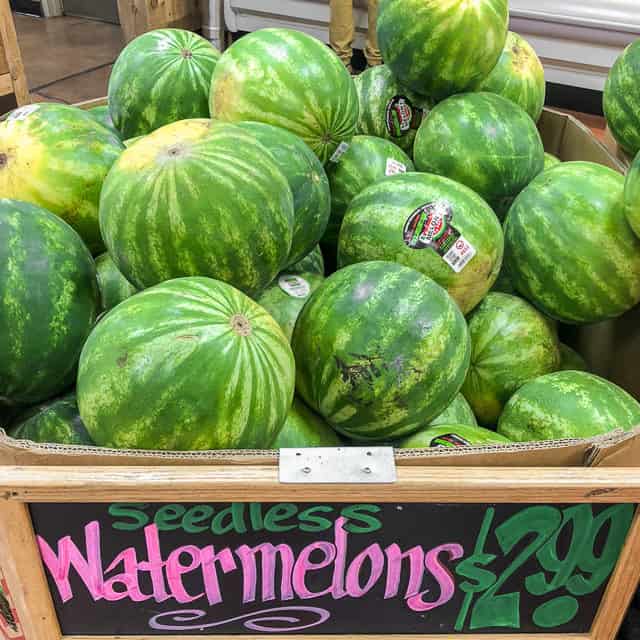
This applies to pretty much all produce, but you want to pick a heavy watermelon, meaning the one that is the heaviest for its size. That means there’s more water in it, which means a juicy watermelon.
The easy way to check for this is to pick up a few melons and compare their weights (or, if there’s a scale nearby, actually weigh them).
The whole watermelon pictured above here in my post was a whopping 18 pounds! It was heavier than the other comparably sized melons around it. It’s more bang for your buck too.
Tip #5: Check for a Uniform Shape
Some watermelons are round, some are oval, and either is fine. They are just different varieties. But if there are irregular bumps, this indicates the melon may have gotten inconsistent amounts of sun or water, and you should avoid that one.
Tip #6: Look for the Sugar Spots and Pollination Points
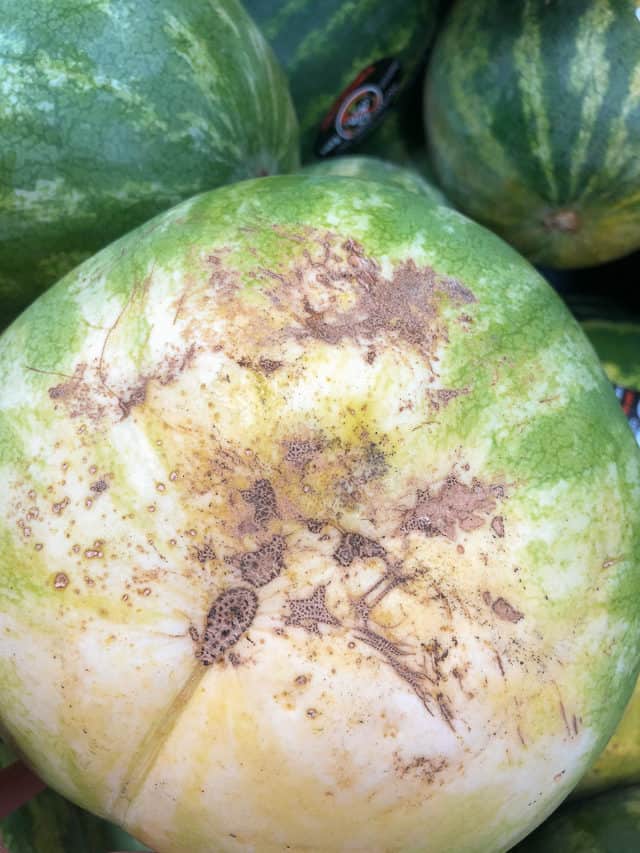
This tip was emailed to me many months ago by Tom, a produce manager for a major grocery chain. If you see black spots on the melon (as pictured above), this is where sugar is seeping out and indicates a sweet melon. At first glance, a sugar spot might just look like dirt, but if it doesn’t rub off easily, then it’s a sugar spot.
Also, if you see dots in a line (not a scratch), these are pollination points, and the more of them the better. I’ve been looking for these every time I pick up a melon and have had great luck with it in addition to the other tips. Thank you, Tom!
Though the above melon did not have a creamy yellow spot (it’s a little white), the sugar spots are a good sign. It was indeed a sweet watermelon.
What about the stem?
I’ve never seen a watermelon with its green stem on, though perhaps you’re more likely to find one at a farmers market. Odds are it won’t come up anyway, but I don’t know if any ripeness indications from the stem.
Once you’ve picked out a good watermelon, take a look at my quick guide for How to Cut a Watermelon, which is how I always cut watermelon to keep in the fridge. But is especially the best way to serve this delicious fruit for parties and entertaining.
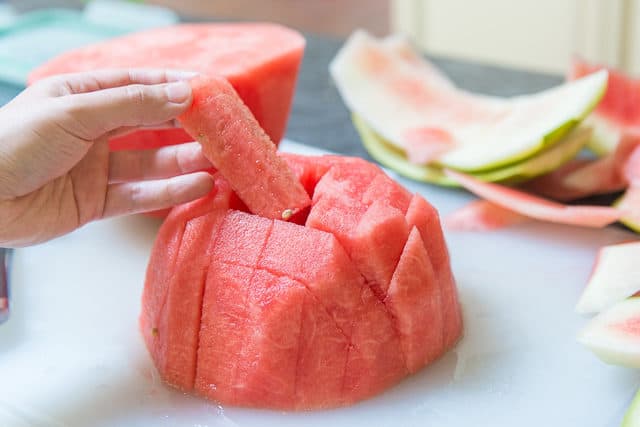
The middle of the watermelon always has the best flavor, so you’ll want to cut away a substantial amount of rind.
This method of cutting is SO much easier than cutting the typical triangles that include the rind, and you can either cut it into sticks or cubes. My perfect slice is actually the stick!
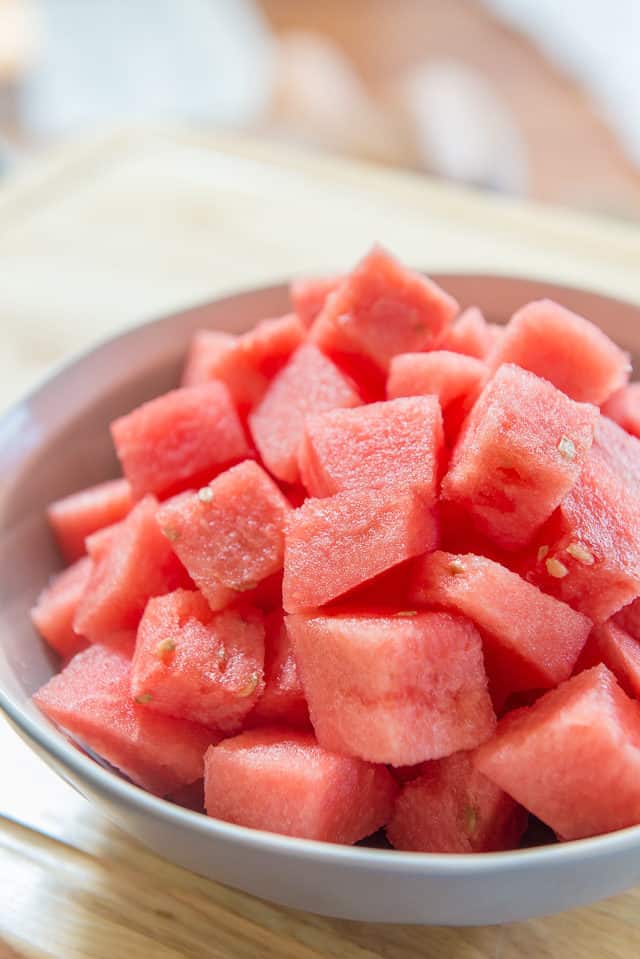
Just make sure to use a sharp knife so you get crisp pieces.
Click the photo above for my guide on cutting. Enjoy watermelon season!
More Tips and FAQ
If it’s cut, the watermelon must be stored in the fridge and can be kept in a large container for up to 5 days. An uncut watermelon can be kept at room temperature for a few days, but I find it’s best to get it into the fridge as quickly as possible, especially since watermelons do not ripen further on the counter.
Yes, but it’s not something you’ll want to eat again in a thawed state. I freeze watermelon to blend into a Watermelon Slushie or as ice cubes for Summer Drinks.
In the South they serve pickled watermelon rinds as a kind of relish, and it’s very good! I’ve never made it myself though. Only had it in restaurants.
Did you enjoy the recipe? Please leave a 5-star rating in the recipe card below and/or a review in the comments section further down the page. Or, follow me on Facebook, Instagram or Pinterest!
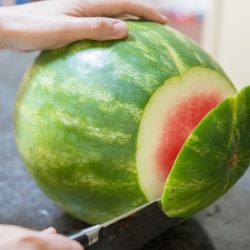
How to Pick a Good Watermelon
Ingredients
- 1 large watermelon
Instructions
- Find the Field Spot – Look for a deep yellow color. If there’s a white field spot, or no field spot at all, it likely won’t be good.
- Pick a Dull Looking Watermelon – A shiny appearance indicates an underripe melon.
- Knock on It with Your Knuckles – Your knuckles should bounce off the melon, and the surface should be pretty hard/firm. Soft flesh indicates it’s starting to spoil.
- Get the Heaviest One for Its Size – This applies to pretty much all produce, but you want to pick the watermelon that is the heaviest one for its size. That means there’s more water in it.
- Check for a Uniform Shape – Some watermelons are round, some are oval, and either is fine. But if there are irregular bumps, this indicates the melon may have gotten inconsistent amounts of sun or water.
- Look for the Sugar Spots and Pollination Points – If you see black spots on the melon, this is where sugar is seeping out and indicates a sweet melon. Also, if you see dots in a line (not a scratch), these are pollination points, and the more of them the better.
- If you want an easy way to cut the watermelon into sticks or cubes, see my How to Cut a Watermelon post. Enjoy!
Nutrition
Nutrition is estimated using a food database and is only intended to be used as a guideline for informational purposes.
Post updated with new photos and more tips in June 2018. Originally published April 2011.

288 Comments on “How To Pick A Good Watermelon”
This is a VERY useful guide for me, especially since I’m deaf and I have no way of knocking on it and knowing whether the melon is dull or not. I am very grateful for the visual and feel aids!
That’s so great Nikki! Good luck and happy watermelon picking =)
I have also found a watermelon with a scar is super sweet. I think it is because the vine has to send extra nutrients to repair itself.
That’s really interesting, I’ve never heard of that one. Thanks for sharing!
I was picking a watermelon one day, when a little old scruffy man, told me he had been a watermelon farmer for 30 years and he showed me how to pick the right one. He told me that the “scars” on melons are actually “sugar marks”. That the sweeter melons will have sugar marks, but too many isn’t good! So I incorporate the sugar line method with the thumping and get a great melon every time!
Oh, thank you for sharing the farmer’s tips! I seem to look for those sugar marks and bee stings, too! Unfortunately Western Washington doesn’t get the best tasting fruit in general.
What do you mean by “scars”? Are those the lines on the melon?
I have heard this also. Where I am from we have a lot of watermelon farmers. The sugar marks are the “stretch marks” of the watermelon that kind of looks spongy. Not the normal stripes watermelon have. Also check the stem on the water melon. Sugar will begin to seep out of the stem as well.
Very cool, thanks for sharing!
Someone once told me that in order to pick a sweet cantelope you should find one that is more yellow in color. The belly button thing also works well.
Great tips i love watermelon but how do you tell if it’s overripe? That is sometimes more disappointing to me than an underripe watermelon.
If it’s overripe the watermelon will start to get soft and mushy. Make sure the watermelon you pick is nice and firm. Hope that helps =)
I have another tip…in addition to these things…look for bee stings, that means the watermelon is sweet.
YES! I worked for a women in VA and she taught me about the bee stings. I have never looked for anything else. No thumping, pushing required. We always choose an amazing watermelon. Once it is sliced and chunked, it’s gone within 24 hours! I have to scoop out some before the fam gets to it to make sorbet for slushies. Again, gone super fast.
I have another tip…in addition to these things…look for bee stings, that means the watermelon is sweet.
I had a produce team lead from Sam’s club tell me that the thing that indicates be stings are the tracks on the watermelon. The more tracks the more bees the sweeter the melon.
yes, the bee sting. My produce guy showed me that too. Look for a small poked, or scarred area, with some dried up scar sap, that means the bees were eating/sucking it because it is a sweet one. If you find a watermelon with a few of these “scars” you’ve scored!
I have to admit, I was skeptical about this since I rarely get a nice watermelon. Guess what?? They had minis at Costco. So I followed your tips and that sucker was a yummy one! They worked!! Wahoo!! Here’s to a successful watermelon picking season.
OK now I want watermelon LOL. Now if someone could write how to choose a coconut Id be great. I bought one which sounded like it had lots of the coconut water in it and when I hit it the entire inside had seperated from the coconut and there was mold growing in it 😛 Gross.
Thanks for the tips! Definitely gonna try them soon!
If there is bumps on yor watermelon and it is cause by the drought that we had inmissouri for the last two months will it affect flavor?
Hi Dusty, Yes, irregularities in smoothness or shape are an indicator of uneven watering, which it sounds like it did experience exactly that because of the drought. Did you grow your own or something? Who knows, maybe it will still taste good, you never know!
Watermelon Jenga – new summer sport! Can’t wait to try out what I have learned! Love your site!
Thank you Sharon =) LOL Pete and I don’t have jenga so we have an alternative hehe
Thanks for the Watermelon picking tips! I am looking forward to trying these out. As for canteloupes, I do believe you can pick a good one by pressing on its “belly button”, the spot that was attached to the stem/vine. It should be a little soft and bouncy, and if you put your nose up against it you should be able to smell the sweet, tasty insides. I think the field spot and weight vs. size ratio is important with cantaloupes as well. Good hunting, everybody!
Mary Helen, those are great canteloupe tips, thanks for sharing them. Those are the only two tips I have heard of. I haven’t noticed the field spots on canteloupes but will start taking a look!
I asked a produce clerk how to pick a good cantelope. He said to look for mostly brown coloring under the webbing. Works every time.
Fantastic! Thanks for sharing Judy!
Smell is by far the best way to pick any melon. Good smell=good taste. No smell=no taste.
Thanks for the chopping tutorial! I’m about to slice up my probably less than stellar mellon to freeze for slushies and teething treats for the baby. Your method seems much less complicated than my usual slicing in half and hoping for the best routine.
This method of chopping is much quicker and is the easiest way to deal with watermelon. What I used to do is cut it into slices, then sort of slide the knife under the rind…but it was so time consuming because I would have to do every single piece individually! This way takes only a couple minutes to slice up the entire watermelon.
Thank you for vindication, lol! I’ve been cutting my watermelons this way for years and always get funny looks/comments. It was just easier and faster for me. Appreciate the tips on picking the best method, too. I knew about the thumping but not the rest. Can’t wait for watermelon season!!!
HAHA that’s so funny! It’s definitely the smartest way to do it 😉
This is actually how the professionals chop up ALL melons (it works WONDERS on cantaloupe and honeydew as well..) My husband is a professional chef, and when I’d help out in one of his old jobs in the catering kitchen I’d spend a lot of time prepping all the melons for the fruit platters…you could get a couple dozen melons done quickly…then they’d leave then cut in half on a cookie sheet until we had to slice them for use on the platters…
I’ve always cut my watermelon into slices and then slide the knife under the rind but not anymore; I am definitely trying your method out! I love having cut and ready to eat pieces of melon in the fridge. I’ve not tried the pickled melon rind before but my mom has made kimchee from the watermelon rind once or twice. 🙂
My dad uses the knocking method! And always ends up picking the best watermelon! =]
When I knock on a watermelon, I listen for a really nice hollow sound, like knocking on a wooden door. Works every time. I always compare several melons and pick the most resonant one. I never thought about the dull appearance of the skin, but I’ll look for that now too.
What I really need is a tutorial on picking a canteloupe! When they’re good, they’re so great, but when they’re bad… do you ever notice they sometimes have a slight fishy taste? In general, though, I just seem to end up with underripe canteloupe or honeydew.
Amy, I know what you mean about the canteloupe! I have had a few bad canteloupes myself, and it is very disappointing. I think I know what you mean about the slight fishy taste…when a melon goes slightly bad, it has a really gross rotten taste and aroma to it. The only canteloupe tips I know are covered by Mary Helen in a comment below…make sure it smells fragrant and push on that belly button to see if it gives slightly.
An amish girl told me to pick a cantalope with white around the stem where it came off the vine, if it is green it is not ripe, and of course the smell is wonderful when the stem is white.
Push in their belly buttons (indention where it was picked from the vine). If it gives, the canteloupe is ripe. If its hard, the melon is underripe. Needless to say, if you push through and get mush, too ripe.
one really good way to get a good cantaloupe is to find one that is as smooth as possible—the rougher it is, the greener it is.
This is what my mom taught me, listening for the right sound, and it seems to work really well. People look at me weird when I put the watermelon up to my ear and give it a couple taps, but I can only remember a couple times when it thumped really deep and hollow sounding and came out being a dud.
I really appreciate this tutorial. One day I walked in to my favorite mart and I heard a lot of thumping…yep, they were having a watermelon sale and I really thought I was at a pow wow….now I can join the crowd thanks to you…
Happy watermelon picking!
To pick a good cantelope the most important thing is to make sure there is no stem left on the “belly button” (I never heard it called that before but love it”). If there is stem left, it was not ripe when picked.
Nancy
The navel also needs to me slightly soft. If it is rock hard, it’s not ready yet.
You can also smell the stem end of a cantaloupe and if it smells sweet, then it’s good. If you smell nothing, it will taste like nothing!
The skin under the “mesh” needs to be brown as well….if not then it was picked too early & wont be sweet, even if you “let it ripen”